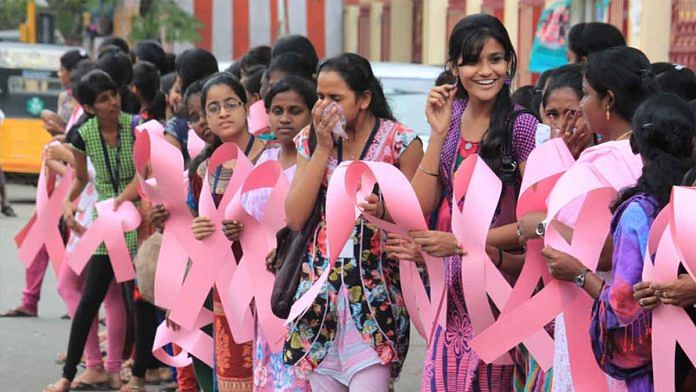New Delhi: The cost of treatment for early-stage breast cancer treatment would represent about 10 years of average annual wages in India, the World Health Organization (WHO) has said in its World Cancer Report.
“The cost of targeted treatment on the WHO EML for early-stage HER2-positive breast cancer, for example, would represent about 10 years of average annual wages in India and South Africa and 1.7 years in the USA,” says the report released on 4 February.
Highlighting the “socio-economic inequalities” as a major cause of increasing burden of the disease, the report says one in 10 Indians would develop cancer during their life-time and one in 15 Indians would die due to cancer.
The report estimates 11.6 lakh new cancer cases, 7.84 lakh cancer deaths, and 22.6 lakh 5-year prevalent cases in India’s population of 1.35 billion.
WHO’s assessment of the productivity loss due to premature death from cancer in Brazil, China, India, the Russian Federation and South Africa in 2012 “indicated a loss of US$ 46.3 billion, corresponding to 0.2-0.5% of total gross domestic product (GDP)”.
New therapies increase survival chances but not affordable
While some innovative therapies have a sizeable impact on cancer outcomes, the report says the “socio-economic inequalities” are a major cause of increasing burden of the disease.
“These cancer medicines are very effective, with, for example, an absolute 30-40 percent gain in survival… Selected new cancer therapies are significantly improving life expectancy and quality of life, yet many innovative therapies confer only modest benefits.”
Unfortunately, approved medicines are not available to a majority of cancer patients. “For example, in high income countries, only 13 per cent of cancer patients benefit from immunotherapy and 4.9 percent from genome-targeted therapy. These medicines are unavailable and unaffordable to the vast majority of people globally without insurance coverage or financial protection,” the report says.
India does not feature as a high income country but is among low and middle income countries (LMIC).
The WHO report mentions Prime Minister Narendra Modi’s flagship health insurance scheme, Ayushman Bharat — Pradhan Mantri Jan Arogya Yojana (PM JAY).
It highlights that the Indian government through “the National Health Authority of India, responsible for implementing the national health insurance scheme PM JAY, is discussing cancer treatment packages and pricing of services to be covered in the programme”.
Also read: Genomics data banking could revolutionise healthcare, but comes with unmitigated risks
Cancer and socio-economic inequalities
According to the report, the six most common cancer types are breast cancer, oral cancer, cervical cancer, lung cancer, stomach cancer and colorectal cancer which account for 49 per cent of all new cancer cases.
Cancer patterns in India are dominated by a high burden of tobacco-related head and neck cancers, particularly oral cancer, in men and of cervical cancer in women. And both these cancer types are associated with lower socioeconomic status.
“The burden of cancer types associated with overweight and obesity, lower levels of physical activity, and sedentary lifestyles, such as breast cancer and colorectal cancer, is increasing, and these cancer types are associated with higher socioeconomic status,” says the report.
The WHO acknowledges that India has had “one of the world’s best performing and most stable economies, which has grown by more than 7 percent annually in most years” during the past two decades.
However, it adds, “this economic development has given rise to vast socioeconomic changes, with an increasing risk of noncommunicable diseases, including cancer, and significant disparities in access to cancer prevention and control services”.
Also read: Breast cancer detection gets a boost from Google and artificial intelligence



